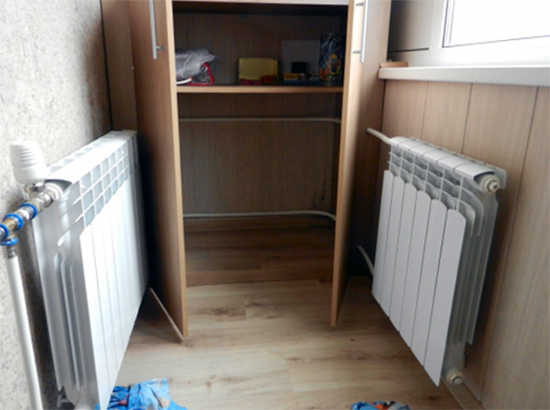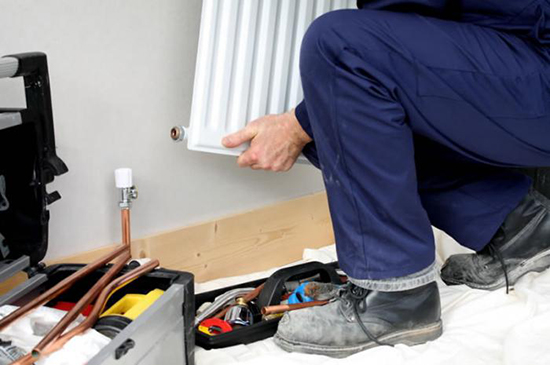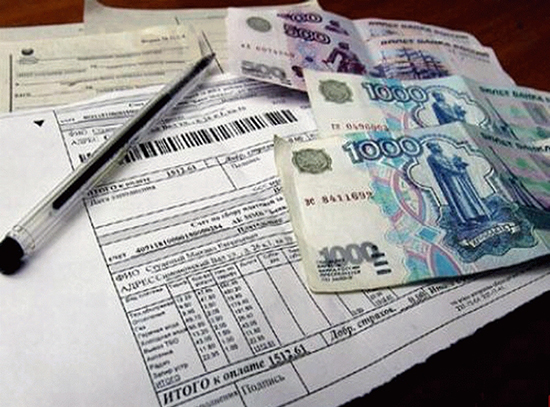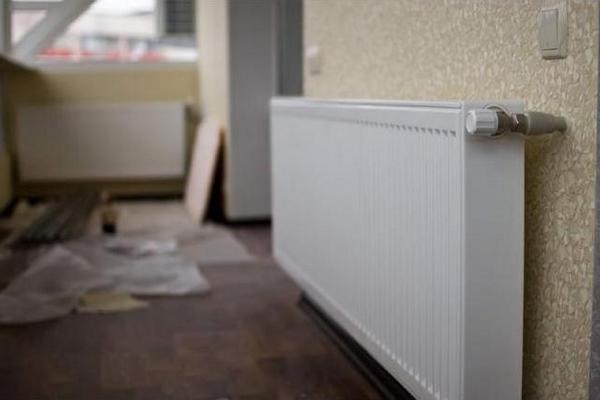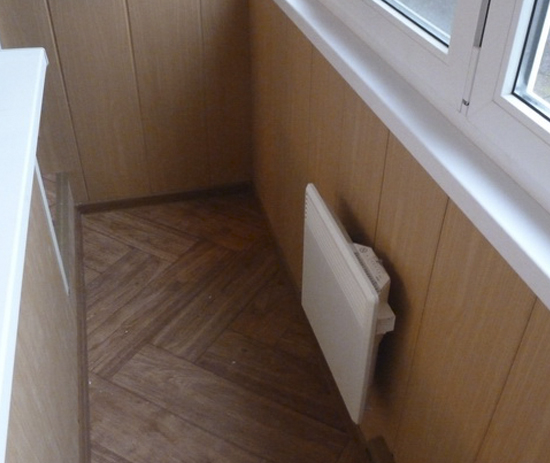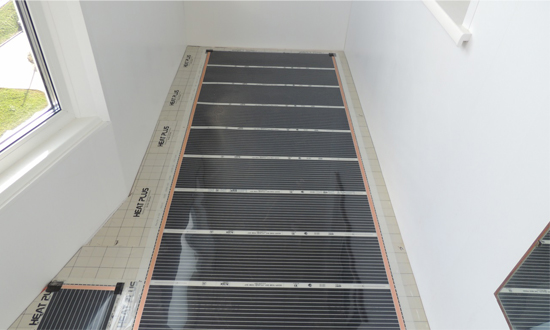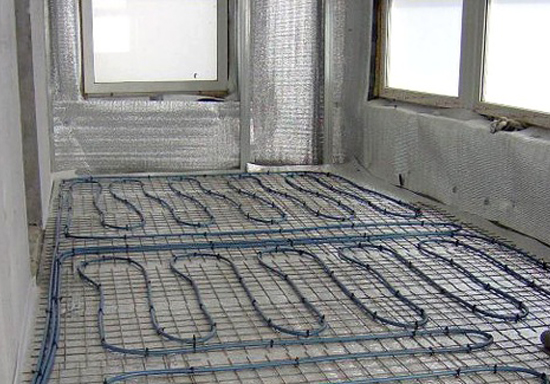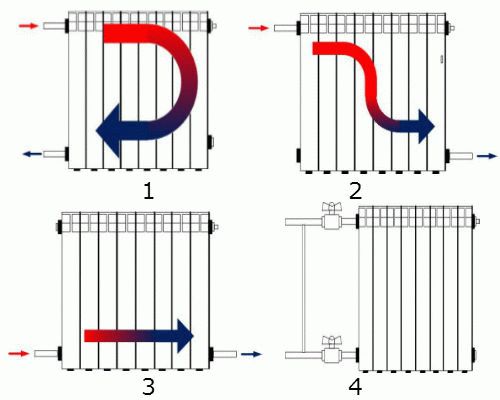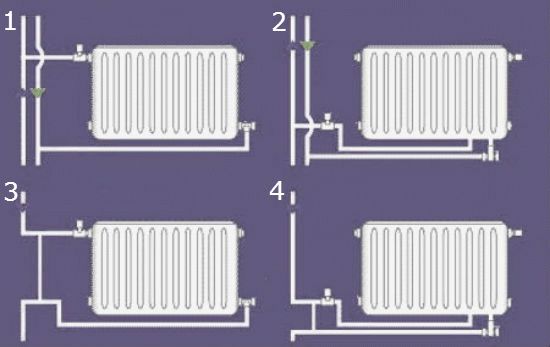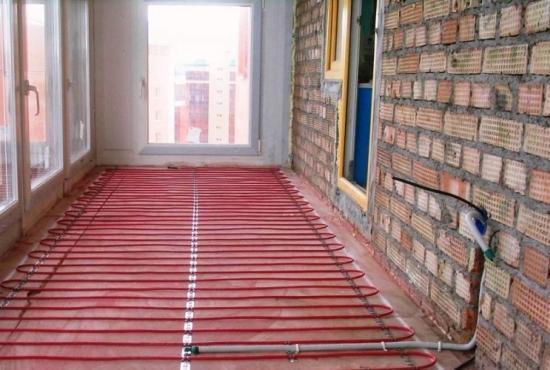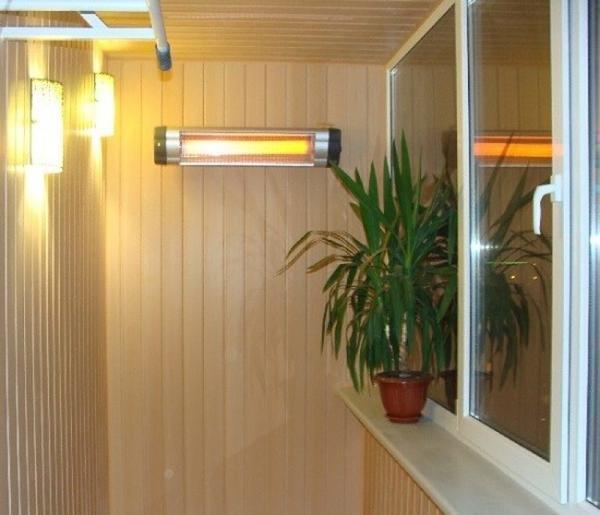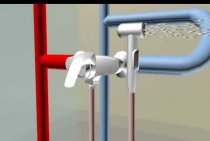Installation
Work on installing, moving and replacing batteries is best done in the summer, when there is no water in the system. During the heating season, before carrying out work, you need to obtain permission to disconnect from the network from the service company (not free), block the riser at the strictly permitted time (which the neighbors will obviously not approve of).
Carrying out such work requires professional training and the availability of tools.
Particular attention should be paid to sealing all joints - this will depend on the reliability of the system operation
Basic rules and requirements
For good heat transfer, the following distances and conditions must be met:
- from the top of the battery to the window sill at least 10 cm;
- from the bottom of the battery to the floor at least 12 cm;
- at least 2 cm from the wall;
- the window sill should not block the radiator;
- the slope of the supply pipes should be 0.5 - 1 cm per linear meter;
- the radiator must be located strictly in the vertical and horizontal planes - this is checked by the level;
- you should try to avoid a large number of kinks in the pipes, as this can lead to the formation of air pockets and reduce the efficiency of the system;
- it is advisable to install a jumper with a tap - this will allow you to regulate the flow of coolant and the temperature in the room.
Work procedure
- Dismantle the old radiator in the room. It is also necessary to cut the pipes at a distance of 10 cm from the connection points - if you decide on such a redevelopment, then it makes sense to replace the liner at the same time.
- Make holes in the wall or balcony partition through which the pipes connecting the radiator and the riser will pass.
- Pass pipes with threaded threads through the holes so that they go into the room by 8 - 10 cm.
- Consistently install all connecting elements (fittings, piping) from the side of the room. Details of the required dimensions must be threaded.
- Mark the location of the battery. Install and secure brackets.
- Mount the battery, adjust the correct hitch using a level.
- Mount jumpers, water inlet and outlet channels from the side of the balcony. Install Mayevsky's faucet for air release.
- Connect to the general system and check the operation of the radiator.
When it comes to heating an attached loggia in an apartment building, in most cases it makes sense to consider other options: underfloor heating, infrared ceiling heating. Such systems are no less effective, and the installation does not require approvals.
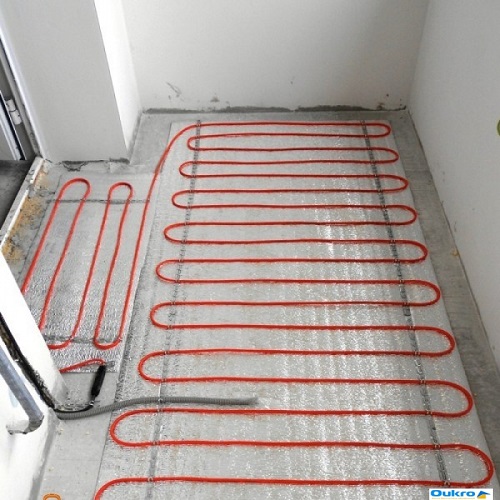
Things to consider when transferring
The first and main obstacle to such a solution is the Housing Code of the Russian Federation, which categorically prohibits transferring engineering communications to balconies and loggias, including radiators. In very rare cases, it is possible to obtain official legal permission for such redevelopment in apartment buildings. But the owners of private houses can carry out this type of work quite calmly.
The second important factor to consider is the condition of the exterior walls. It makes sense to install any heating system in well-insulated areas, otherwise no method will be effective. In addition, if the wall freezes through, then there is a high probability of water freezing and a radiator breakthrough. The consequences are not only a fine for illegal redevelopment, but also payment for the repair of apartments located below.
Transferring the battery to the loggia
Important: Removal should be done only in the warm season, when the heating is turned off. Work is carried out only after glazing the loggia and carrying out work on its insulation
Marking the place where the battery will be installed is carried out.It should be close to the bearing wall, but be at some distance from the door.
If the loggia area is about 6 sq. m and less, then for its heating you need 3-4 sections of the battery.
- Bulgarian, perforator and file.
- Steel plates.
- Mounting foam and cement mortar (1 part cement to 3 parts sand).
At the installation site of the battery, the grinder makes small recesses for mounting the entire structure.
Opposite the tie-in points of the battery on the main pipe, a through wall is shredded with a perforator. The holes made must be expanded to a pipe diameter of +50 mm.
- Battery, pipes and fittings.
- Sealant, die and vise.
- Welding machine and tape measure.
On the main pipe, a cut is made with a grinder and an external thread, on which fittings with an additional branch are installed.
Pipes with a protrusion of 9 cm are led through the wall. Threads are similarly made at their ends for attaching corner fittings.
After these works, the installation of vertical pipes that supply and discharge water from the battery is carried out - they are screwed into ready-made fittings.
A detailed process of installing a battery on a loggia can be viewed on the video:
What to consider when choosing a heater

To choose the right heater for the balcony, you should consider the following features of the technique:
The power of the device. It depends on the rate of heating of the air in the room.
Homeowners need to remember that powerful appliances require careful handling, they cannot be connected to a network with a TV, washing machine and other similar equipment, they consume a lot of electricity. If you do not have the opportunity to connect them, take simpler analogues.
Device mounting options
Before ordering convectors or a warm floor system, think about whether you can install and connect it correctly. If not, it is advisable to choose a simpler version of electric heaters: an infrared lamp, a fan heater.
functional features of the room. If you need to provide heating for a balcony in winter for a couple of days, it makes no sense to install expensive heating equipment on it, a conventional fan heater will suffice. If the balcony is used as a separate room, it is better to install a "warm floor" system or convectors on it.
Work safety. Do not use high temperature appliances if you have inquisitive pets or small children. In such cases, it is better to choose the safest options: infrared heaters or a “warm floor” system.
If you cannot decide which heating equipment to use for your balcony, contact the specialists on this issue. They will take into account all the features of the operation of this premises and select the most suitable option, taking into account your budget.
We adhere to the letter of the Law
Carrying out the removal of the battery to the balcony without completing the relevant documentation, you need to understand that after this event you run the risk of "running into trouble", the most minimal of which will be the imposition of a fine on you.
But, in this case, the case will not be limited to the payment of a fine. You will either have to dismantle the battery installed outside the apartment, or, having received written confirmation from all the owners of the living space, prove in court that such an alteration is safe for the heating system and does not affect the quality of life in the house of other residents.
Based on your application, the court will make an appropriate decision. He can allow the changes you made, after which they will be made to the Technical plan of the apartment or declare them illegal. Then you will have to dismantle the installed equipment within the specified time frame.
If you doubt the need to move the radiator, we recommend that you familiarize yourself with an alternative heating option.How to make a warm floor on the balcony with your own hands, read on our website. The article discusses the features of all variants of this system.
It is also possible to use ceiling infrared heating on the balcony. It has a number of advantages and is much easier to install.
But whichever option you choose, in any case, heating will only make sense if the room is well insulated. How to do it right, we told here.
Why is it difficult to get permission?
Obtaining permission to install a central heating radiator on a balcony or loggia is difficult for a number of reasons.
Firstly, the central water supply system is designed for a strictly defined number of heating devices (radiators), which is indicated in the technical passport of the house. Therefore, the battery on the balcony - this is the installation of an additional heating device (radiator) entails a decrease in pressure in the coolant system and, as a result, a decrease in its temperature in proportion in all apartments.
Secondly, neither balconies nor loggias are residential premises, and heating of a loggia or balcony is not provided for by any technical standards. Even the most thorough insulation of these external structures does not guarantee that the heating radiators brought to them with their own hands will not defrost when lowered and the heat supply throughout the house will not stop.
Thirdly, payment for utilities for heating is charged based on their technical passport of the apartment, which indicates the number of radiators installed in it. Installing additional radiators is essentially stealing heat energy from the service organization, just like using electricity or water supply bypassing existing individual meters. Even if you, in any way, manage to bring them to the balcony, having received such a “permission”, it will still require changes to all the technical documentation of the apartment building, which you will have to pay at your own expense.
It will also be necessary to make an additional payment for the amount of heat received from the heating radiator placed on the balcony.
Heating on the loggia, how to organize
Installing heating on a loggia is only the first step towards arranging a full-fledged residential area on it. Even the most perfect insulation can only retain heat, but does not produce it itself. That is why the loggia needs heating. There are several ways to organize heating on the loggia, photo below.
Warm floor
- Electric underfloor heating - contrary to popular belief, it does not consume so much energy (180-200 W / sq. M.). Like any electrical appliance, such a warm floor requires the organization of wiring on the loggia. The cost of such heating is quite high, but quickly pays off due to the reliability and efficiency of the warm floor. Can be installed under all types of floor coverings, except for floorboards.
- Water heated floor - ease of installation and low cost of materials make this type of heating in demand. A warm water floor on a loggia can be installed under any cover, but its main disadvantage is the need to connect to a heat source, which is usually a central heating battery - and this is rarely legal. In addition, leaks are possible, which are extremely difficult to eliminate.
- Infrared floor heating is a rather expensive, but effective way of heating a loggia. Film heating elements are installed under the finish. The principle of operation is to heat surfaces, not air. Among the disadvantages is fragility, so you should not install infrared underfloor heating in areas where heavy furniture will stand. It is best to install such a warm floor under porcelain stoneware, laminate or linoleum.
The advantages of underfloor heating are:
- Uniform heating of the entire floor surface.
- Visual absence of the battery.
- Saving usable space.
- Ensuring a comfortable room temperature.
Electric heating
This group of heating devices includes:
- Oil heaters.
- Electric fireplace.
- Air conditioner.
- Electric convectors.
The convector is the simplest and most common type of heater for the loggia, but it requires the mandatory installation of an outlet, that is, you first need to conduct electricity to the loggia.
For heating loggias up to 5 sq. m. You can install a heater with a power of 1 kW, which will provide uniform and fast heating of the room. Such heating does not dry out the air, but with constant use it is costly.
Removal of central heating to the loggia
Removing the battery is the most economical, but has its significant drawbacks:
- To transfer the battery to the loggia, you will need BTI permission, which is quite difficult to obtain.
- There is a possibility of a pipe burst, which will have serious consequences. This can happen if the heating is temporarily turned off.
Important: The main reason for the ban on taking the battery to the loggia is to reduce the pressure in the heating system, as the number of consumers increases
Migration issues
Asking the question whether it is possible to take the battery out to the loggia, on the one hand it seems that there is nothing special and complicated in transferring the heating radiator from the adjacent room to this part of the apartment. After all, the balcony itself will be thoroughly insulated before this procedure is carried out, so you don’t have to worry about possible heat losses associated with an increase in the useful area of the room. However, in practice, it is very difficult to implement this idea, if only because such a move is not approved by the Housing Legislation without obtaining the appropriate permission.
According to paragraph 1 of Article 25 of the Housing Code of the Russian Federation, the transfer of engineering networks is part of the reconstruction of a residential building. But balconies, loggias and some other types of premises do not belong to this category. Therefore, the transfer of radiators there is strictly prohibited. The following arguments can be cited as weighty and adequate arguments in favor of this prohibition:
The option of placing the radiator on the balcony
How to heat a balcony
Do you need additional heating of the balcony or will its proper insulation and glazing cope with the cold? Unfortunately, these measures are not enough to keep the temperature on the balcony above 18 degrees in winter, that is, comfortable for a person. There are many ways to make heating on the balcony, consider the most common ones.
Electric convectors
An electric heater may well replace a central heating battery. The advantages of such heating are:
- Compactness.
- High efficiency.
- The surface temperature does not exceed 60 degrees, so the air does not dry out.
- Low power consumption - about 200 W/sq. m.
Balcony heating with a convector
There are several options for installing the convector: on the floor or on the wall. But air circulation should be taken into account, so the heater on the balcony should be located under the windows to reduce heat loss.
Important: When wall mounting the heater, you should avoid installing brackets to the wall through the insulation, since the operation of the device can lead to freezing of the mounting and destruction of the finish.
To connect an electric convector on a balcony, a separate outlet is required, so you should take care of the wiring before installing it.
infrared heating
Such heating is unique, because it does not heat the air on the balcony, but the objects on it, which accumulate this heat, which makes it possible to reduce the heating temperature. Thanks to this heating, the air on the balcony does not dry out.
An infrared film acts as a heating element, which can be laid on the floor, photo below, or on walls and ceiling under plaster.
Infrared heating on the balcony will replace the battery
Most often, it is placed on the floor, but you should be careful, because heavy furniture can damage a fairly thin layer. The power consumption of such heating is much lower than in traditional underfloor heating, therefore, it is a very economical option.
Warm floor
Warm floor do it yourself
Despite the relatively high cost of both materials and installation, underfloor heating is quite economical - 150-200 W/sq. m., are durable and quickly pay off. This type of heating can be installed under almost any floor covering, with the exception of natural wood, which is not designed for temperature changes.
Water heating
The simplest and most common way to heat a balcony is to move central heating to non-batteries. But it is worth saying that recently the output of the radiator to the balcony is prohibited. This happened due to the fact that when installing batteries on the balcony, many residents do not receive enough heat.
Important: Incorrect installation of the battery can lead to a pipe burst and flooding of neighbors, and if such heating is not agreed upon, a fine and litigation.
Despite all the prohibitions, apartment owners still install central heating batteries on the loggias, since this is practically not associated with costs, except for the installation itself, and the heating is full-fledged.
Option Oh, Lucky
If you still decide to seek permission to move the central heating battery to the balcony, then you need to:
- carry out engineering calculations of the thermal conductivity of balcony insulation;
- get a conclusion from a licensed specialist that it is impossible for the battery to freeze on the balcony;
- perform insulation and glazing of the balcony;
- obtain permission to transfer;
- select and approve a scheme on how to make heating;
- installation of batteries and connection to the heating system.
Tip: If you plan to do the heating of the balcony with your own hands, then before removing the batteries, it is recommended to paste over the wall under the heater with a foil screen, this will eliminate heat loss to heat the wall.
Section calculation
According to SNiP standards, in order to avoid freezing of the heating system, mainly in the corners, the length of the battery must be at least half the length of the window. In addition, each type of battery has its own heat transfer characteristics of 1 section:
- aluminum for 2m 2 of heated area;
- bimetallic for 1.5 m 2.
Step by step instructions on how to install batteries:
- We make markings for radiators. The distance from the window sill to the upper part is less than 100 mm, from the bottom to the floor - at least 120 mm, from 20 mm or more from the wall.
- Brackets are installed, the main weight must be supported by the upper mounts. Up to 12 sections - 2 on top, 1 on the bottom to eliminate the mobility of the lower part. If the battery is larger, additional top mounts are required.
- We hang the batteries, check the level of the horizons and verticals.
Connection
To prevent the formation of an air lock, make sure that there are no kinks in the lower pipe in the direction from the radiator up, the lower pipe in the opposite direction.
How to put batteries:
Installing a battery on a balcony
- Lateral.
- Diagonal.
- Lower.
- With a bypass for regulating the supply of coolant.
If the battery is 12 sections or more, it is advisable to connect the heating diagonally.
Scheme of connecting the battery to the central heating system
Scheme of connection to the central heating system:
- Two-pipe lateral connection.
- Two-pipe bottom connection.
- Single pipe lateral.
- Single pipe bottom.
Video on how to install the battery
But if you decide to connect the heating of a balcony or loggia with your own hands, then first of all turn off the supply of the heater.
Important: If there is no shut-off valve, then batteries should be installed outside the heating season
- Cut off the old battery.
- Install an inlet faucet.
- Screw the connecting pipe into the battery and into the tap through the fittings.
Tip: For sealing and tight connections, use fum tape or tow.
Connecting the battery to the central heating system is the most crucial stage in the work, it is better to contact certified specialists, then in case of leaks they will answer.
The article was written based on materials from sites: schoolremont.ru, klivent.biz, balkonsami.ru, oknanagoda.com, house-lab.ru.
Water heated floor heating loggia
How to heat the loggia? You can install a modern system with the well-established name of a warm floor. Of the options, there are both electric underfloor heating and water underfloor heating. Very often the choice leans in favor of the second option.
Water floor installation:
- First, a concrete screed is laid;
- Then the concrete screed is leveled;
- Then the insulating material is laid;
- Then plastic pipes are laid, the basis of the underfloor heating system, the pipes are laid in a snake, at a relatively small distance from the bends;
- Plastic pipes are connected to the hot water supply system;
- Then the concrete screed is laid again.
Hot water is used for heating. The disadvantage of this method is the complexity of the process. The same electric underfloor heating will be easier to install.
Connection to the heating system
The tie-in into the central heating riser must be done not only technically competently, but also so that it is imperceptible to the neighbors. Or, at least, so that their living conditions do not deteriorate so much that they turn to judicial protection. How to do it?
Battery placed on the balcony
Insertion methods
There are two ways to connect to the hydraulic system: serial and parallel. A parallel method in the simplest words is described in one of the construction and repair forums:
With the sequential method, the tie-in is carried out at the outlet of the donor battery, and after the additional battery is powered, the pipe extending from it is connected to the "cold" part of the donor battery.
Pros and cons of the two types of connections
Connection in parallel with a steam heating radiator behind a wall
When connected in parallel, the cross section of the water flow to your apartment increases. Exactly on the area of the hole through which you supply water to the additional battery. How critical is it?
Let's say you live in a five-story building. The heat riser raises hot water from the basement through the radiators of five apartments to the top floor and, with its other branch, lowers it down through five other radiators.
Thus, 10 batteries “sit” on one riser, your additional one will be the 11th. The cross section of the watercourse will increase by 10%, respectively, the pressure will drop, it will not be difficult to fix such a noticeable value through elementary observation of the pressure gauge. If your neighbors have claims against you, then legal showdowns cannot be avoided.
Then the parallel watercourse must be blocked, the water from the branch must be drained, the balcony should be used in the unheated room mode for the time of frost. This is the lesser of evils.
More - pipe rupture will cost a pretty penny.
When an additional thermal circuit is connected in series, the total cross section of the watercourse does not increase, the pressure in the system does not drop, but this does not mean that the temperature in the neighbors' apartments will not drop: after all, you heat your balcony, the coolant loses its calories in this area, and no matter how scanty these Losses, as they seem, may be the drop that overflows the cup of your home's heat communication capacity to bear the load.
If the facade wall is saved, hang the battery on it!
It is impossible to disconnect the serial connection with one turn of the valve: you will block either the entire riser or a significant part of the circuit connected to it (depending on the overall design of the heating system).
Another useful tip: if your balcony is not combined with the room, then mount the battery on the wall on the outside of the front wall.
Modern heating infrared heater on the balcony
But, fortunately, in addition to steam heating, there are modern worthy alternatives. You can install a warm floor system or install an infrared heater on the balcony. In the latter case, we are talking about a carbon heater.
Infrared heaters are:
Is such a heater dangerous in an apartment, and even more so a balcony? Infrared rays, one might say, do not have those characteristics that can adversely affect human health. They also do not harm animals and plants. They do not create noise and vibrations, and do not burn oxygen in the same way as some other heaters.
It is even believed that this type of radiation allows the creation of molecules in the air, called anions. It is believed that they purify the air and have a positive effect on all living things. Electricity consumption IR heater will save 20 percent. And you can also install a programmable thermostat. And then you can save electricity by 35%.
How to choose an IFK terrace heater
Infrared electric heaters for a terrace or balcony emit a directional heat beam that is immediately felt by people within its range. Therefore, terrace heating with such devices is more efficient, more economical and safer than gas heating.
What to look for when buying
- When choosing a patio heater, the first thing to check is the materials from which it was made and whether it is waterproof.
- In addition, it is necessary to check the waterproof rating with protection against splashing water from any angle.
- The housing should preferably be made of stainless steel or aluminum with an anti-corrosion coating.
- Choose all-weather IFC heaters.
You do not know what power the heater should choose for your terrace? Here are some tips for choosing a radiator.
How many meters of terrace do you want to heat
Remember that it is usually not necessary to fully heat the terrace. That's why it doesn't matter how big your deck is
More importantly, which allocated area on the terrace (surface) you want to heat. Think about where you usually stay: a sofa, a table with chairs? For example: if this is a table area, and your entire terrace has an area of 50 square meters
M, it is enough to heat about 10 square meters. M terrace area. Because the surface of the table with chairs rarely takes more than 9 m2.
How to choose the power of the heater for the terrace
- The type of terrace is also important when choosing a radiator, i.e. whether it is an open terrace or partially built-up or sheltered from the wind. The less annoying the wind on such a terrace, the less energy the heater needs.
- The most efficient electric patio heaters are short wave halogen heaters.
- The best solution is not always the most powerful heatsink. Powerful heaters are more expensive, and the cost of their operation (heating) is higher. With the optimal choice, you can save on the purchase itself, and then, when using it.
- In addition, not only the power of the radiator determines the perceived thermal comfort. Additional factors affecting the heating efficiency are the distance from the radiator, mounting method and height, angle of inclination, heating element technology, type and method of manufacturing the heat reflector.
conclusions
But whatever it says, infrared heaters are far ahead of conventional convectors in terms of their advantages.
In order to choose the right model correctly, you just need to familiarize yourself with its technical indicators, pay attention to the thickness of the foil, the anodizing layer of the plate that emits rays - the durability of the device depends on this
Also of no small importance is the wavelength, the heating element, that is, the material from which it is made, as well as the power of the heater. It is not worth buying a device that is too powerful for an apartment or a small room, as it can adversely affect well-being
It is not worth buying a device that is too powerful for an apartment or a small room, as it can adversely affect well-being
Also of no small importance is the wavelength, the heating element, that is, the material from which it is made, as well as the power of the heater. It is not worth buying a device that is too powerful for an apartment or a small room, as it can adversely affect well-being
News from partners
